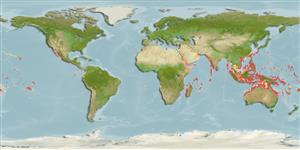Environment: milieu / climate zone / depth range / distribution range
นิเวศวิทยา
เกี่ยวกับทะเล,น้ำเค็ม เกี่ยวกับหินโสโครก; ไม่มีการอพยพย้ายถิ่น; ระดับความลึก 1 - 40 m (Ref. 90102). Tropical; 30°N - 30°S
Indo-West Pacific: Red Sea and East Africa to Samoa, north to southern Japan, south to Western Australia and New South Wales, including Lord Howe Island (Ref. 1602).
ขนาด / น้ำหนัก / Age
Maturity: Lm ? range ? - ? cm
Max length : 40.0 cm SL เพศผู้/กระเทย; (Ref. 30573)
เงี่ยงครีบหลัง (รวม) : 13; ก้านครีบอ่อนที่หาง (รวม) : 20 - 23; เงี่ยงครีบก้น: 3; ก้านครีบอ่อนที่ก้น: 18 - 22.
Juveniles inhabit shallow protected areas, while adults prefer coastal reefs with heavy coral growth providing ample hiding places. Generally solitary or in pairs. Feeds on sponges, tunicates, and algae (Ref. 30573). The young are excellent aquarium fish and suitable for a community tank.
Life cycle and mating behavior
Maturities | การสืบพันธุ์ | Spawnings | Egg(s) | Fecundities | ตัวอ่อน
Myers, R.F., 1991. Micronesian reef fishes. Second Ed. Coral Graphics, Barrigada, Guam. 298 p. (Ref. 1602)
IUCN Red List Status (Ref. 130435)
Threat to humans
Harmless
Human uses
การประมง: มีการค้าเพียงเล็กน้อย; สถานที่แสดงสัตว์และพืชน้ำ: การค้า
เครื่องมือ
Special reports
Download XML
แหล่งที่มาจากอินเตอร์เน็ต
Estimates based on models
Preferred temperature (Ref.
123201): 24.7 - 29, mean 27.8 °C (based on 828 cells).
Phylogenetic diversity index (Ref.
82804): PD
50 = 0.5001 [Uniqueness, from 0.5 = low to 2.0 = high].
Bayesian length-weight: a=0.03236 (0.01300 - 0.08052), b=2.89 (2.71 - 3.07), in cm total length, based on LWR estimates for this Genus-body shape (Ref.
93245).
ระดับชั้นอาหาร (Ref.
69278): 2.7 ±0.00 se; based on food items.
ความสามารถในการกลับคืนสู่ปกติ (Ref.
120179): ต่ำ, เวลาต่ำสุดที่จะทำให้ประชากรเพิ่มขึ้นเป็น 2 เท่าใช้เวลา 4.5 - 14 ปี (Preliminary K or Fecundity.).
Fishing Vulnerability (Ref.
59153): Moderate vulnerability (39 of 100).
Nutrients (Ref.
124155): Calcium = 40.4 [19.8, 68.8] mg/100g; Iron = 0.504 [0.299, 0.837] mg/100g; Protein = 18.2 [16.9, 19.4] %; Omega3 = 0.0889 [, ] g/100g; Selenium = 33.3 [17.3, 64.1] μg/100g; VitaminA = 62.3 [15.0, 242.0] μg/100g; Zinc = 1.34 [0.92, 1.93] mg/100g (wet weight);
